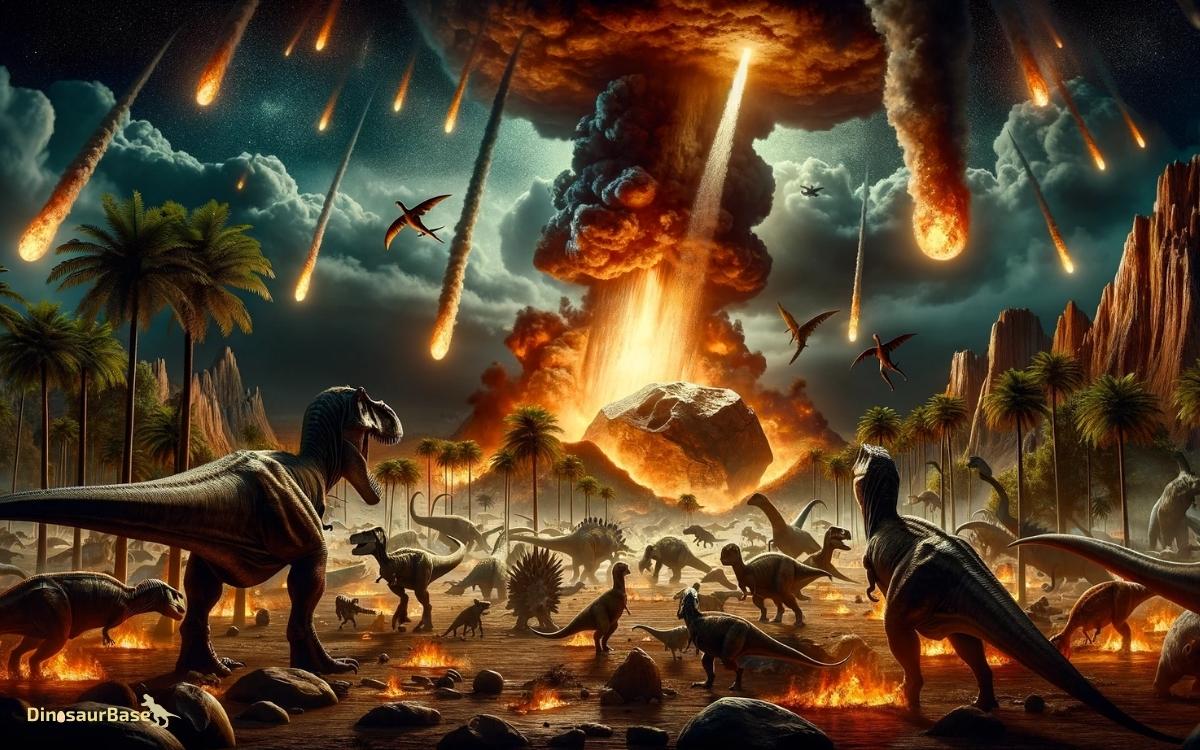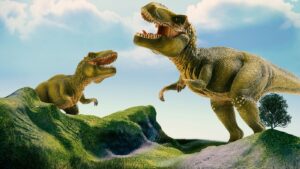When Did Dinosaurs Go Extinct? Unraveling the mystery!
As the curtain fell on the Mesozoic Era, the earth’s greatest titans took their final bow, marking an end to the Age of Dinosaurs around 66 million years ago.
This monumental extinction event, which cleared the stage for mammals and eventually humans to thrive, continues to fascinate scientists and laypeople alike.
The prevailing theory suggests a colossal asteroid impact played the lead role, complemented by a suite of disastrous environmental changes, including significant volcanic activity.
However, recent findings have started to challenge and refine our understanding of this dramatic period.
Unraveling the true nature of the dinosaurs’ demise not only illuminates the past but also offers critical insights into the future of life on Earth, making the exploration of this topic a journey far from over.


Key Takeaway
The Age of Dinosaurs
The Age of Dinosaurs, spanning approximately 165 million years, showcases an era of unparalleled prehistoric biodiversity and complexity.
This extensive period, divided into three distinct epochs the Triassic, Jurassic, and Cretaceous reveals a gradual evolution in dinosaur species, demonstrating adaptability and dominance across various habitats.
These epochs bore witness to the rise and fall of numerous species, each adapted to their ecological niches, with some developing remarkable traits for survival, such as massive size, flight, and specialized feeding habits.
The intricate interplay between these prehistoric creatures and their environments underscores a dynamic ecosystem, constantly shaped by evolutionary pressures.
This era’s contribution to our understanding of life’s resilience and adaptability can’t be overstated, providing invaluable insights into the mechanisms driving biodiversity and species evolution.
Understanding Mass Extinctions
To comprehend mass extinctions, it’s crucial to analyze their causes, which range from catastrophic events to gradual environmental shifts.
Historical records reveal several major extinction events that have drastically reshaped Earth’s biodiversity, highlighting the fragility and resilience of life.
Studying these phenomena provides insight into the complex interplay between biotic and abiotic factors that governs species survival.
Causes of Mass Extinctions
Mass extinctions, catastrophic events that decimate biodiversity, often result from a blend of natural disasters, climatic shifts, and biotic factors, reshaping life on Earth profoundly. These forces disrupt ecosystems, leading to widespread species loss.
Natural disasters, such as volcanic eruptions and asteroid impacts, inject particulates and gases into the atmosphere, drastically altering climate conditions. Climatic shifts, including ice ages and greenhouse phases, further challenge species’ adaptability, pushing them towards extinction.
Biotic factors, such as the emergence of invasive species or the spread of disease, can also decimate populations. The interplay of these elements creates a hostile environment for many forms of life, leading to their eventual decline or disappearance.
Understanding these causes helps scientists anticipate future biodiversity crises, aiming to mitigate their impact.
Major Extinction Events
Building on an understanding of the causes behind mass extinctions, it’s crucial to explore the major extinction events that have punctuated Earth’s history, profoundly reshaping its biological diversity.
The most notable among these is the Cretaceous-Paleogene (K-Pg) extinction event, approximately 66 million years ago, which led to the demise of the dinosaurs, among other species.
This event is often attributed to a catastrophic asteroid impact, combined with extensive volcanic activity.
Similarly, the Permian-Triassic extinction event, around 252 million years ago, eliminated about 96% of marine species and 70% of terrestrial vertebrate species.
This event, possibly triggered by massive volcanic eruptions, dramatically altered Earth’s ecosystem.
These extinction events underscore the fragility of biodiversity in the face of cataclysmic environmental changes.
Impact on Biodiversity
Delving into the aftermath of mass extinctions reveals a profound impact on biodiversity, as these events have historically led to the significant reshuffling of Earth’s biological hierarchy.
The consequences for life on our planet have been both dramatic and enduring, with patterns that include:
- Eradication of Dominant Species: Leading to the disappearance of once-prevalent groups and allowing previously minor groups to proliferate.
- Habitat Disruption: Resulting in the alteration of ecological niches and the emergence of new ecosystems.
- Genetic Bottlenecks: Reducing genetic diversity and thus, the adaptability of species to future changes.
- Evolutionary Innovation: Stimulating rapid evolutionary developments and the emergence of novel species.
These factors collectively underscore the complexity of biodiversity’s response to catastrophic events, highlighting nature’s resilience and its capacity for rebirth amidst destruction.
The Cretaceous Period
The Cretaceous Period marks a pivotal chapter in Earth’s history, characterized by significant shifts in climate that culminated in one of the planet’s major extinction events.
This era witnessed a marked decline in dinosaur diversity, setting the stage for their eventual extinction.
Scholars attribute these changes to a combination of catastrophic events and gradual environmental shifts, underscoring the complexity of factors that led to the end of the dinosaur era.
End of Cretaceous Climate
Climate dynamics during the Cretaceous period, a critical epoch spanning 145 to 66 million years ago, underwent significant transformations that influenced terrestrial and marine ecosystems on a global scale.
These changes were marked by:
- A gradual increase in global temperatures, leading to a warmer climate that supported extensive biodiversity.
- The proliferation of flowering plants, which diversified and became more widespread, shaping the evolution of terrestrial habitats.
- Fluctuations in sea levels, resulting in the expansion and contraction of shallow seas and affecting marine life and coastal environments.
- Variations in atmospheric composition, notably an increase in carbon dioxide levels, which further amplified the greenhouse effect and global warming.
These climatic shifts played a pivotal role in shaping the Earth’s biotic and abiotic systems during the late Cretaceous, setting the stage for significant ecological transformations.
Major Extinction Events
Amidst the climatic fluctuations and biodiversity explosions of the late Cretaceous, a series of catastrophic events precipitated one of Earth’s most significant mass extinctions.
Key among these was the Chicxulub asteroid impact, which unleashed global firestorms, tsunamis, and a ‘nuclear winter’ scenario, drastically reducing sunlight and cooling the planet.
Concurrently, extensive volcanic activity in the Deccan Traps released vast quantities of lava, dust, and sulfuric aerosols into the atmosphere, exacerbating climate change and acidifying oceans.
These phenomena combined to create a hostile environment, severely disrupting the Earth’s ecological balance.
Food chains collapsed as photosynthesis rates plummeted, leading to widespread extinctions across both marine and terrestrial ecosystems. This period marked a pivotal transition, with the demise of dinosaurs and the subsequent rise of mammals, reshaping Earth’s biological hierarchy.
Dinosaur Diversity Decline
Dinosaur diversity began to wane significantly during the Cretaceous Period, marking a pivotal shift in prehistoric life on Earth.
Several factors contributed to this decline:
- Climate Change: Gradual shifts in climate altered habitats, affecting food availability and nesting sites.
- Volcanic Activity: Increased volcanic eruptions released ash and gases into the atmosphere, disrupting ecosystems.
- Competition: The rise of new species led to increased competition for resources among dinosaurs.
- Continental Drift: The breakup of Pangaea into smaller continents isolated populations, leading to evolutionary divergences and extinctions.
This period of decline set the stage for the mass extinction event that ultimately led to the disappearance of dinosaurs. Understanding these factors provides crucial insights into the complex dynamics that govern species survival and extinction.
The Asteroid Impact Theory
A cataclysmic event, marking the end of the Cretaceous period approximately 66 million years ago, was the impact of a massive asteroid on Earth, believed to be a pivotal factor in the extinction of the dinosaurs.
This hypothesis posits that the collision unleashed a global environmental catastrophe, including fires, tsunamis, and a prolonged ‘nuclear winter’ effect due to dust and debris blocking sunlight.
Consequently, photosynthesis was severely hampered, leading to a drastic reduction in plant life, which formed the base of the food chain. This disruption cascaded through ecosystems, devastating populations of herbivorous dinosaurs and, in turn, their predators.
Evidence supporting this theory includes a worldwide layer of iridium, a rare element on Earth’s surface but abundant in asteroids, found at the Cretaceous-Paleogene boundary.
Volcanic Activity and Extinction
Following the discussion on the asteroid impact theory, it’s crucial to examine how volcanic activity also played a significant role in the extinction of dinosaurs.
This section will explore the mechanisms of volcanic triggers and their profound effects on the planet’s climate. Scholars argue that the resultant drastic changes in temperature and atmosphere could have severely disrupted dinosaur habitats, leading to their eventual demise.
Volcanic Triggers Explained
Amid the cataclysmic events that shaped Earth’s geological and biological history, volcanic activity stands out as a pivotal factor in the extinction of dinosaurs.
This phenomenon’s contribution to their demise can be distilled into several critical mechanisms:
- Emission of Volcanic Gases: Vast amounts of sulfur and carbon dioxide were released, altering atmospheric composition.
- Ash Clouds: These clouds blocked sunlight, affecting photosynthesis and food chains.
- Lava Flows: They reshaped landscapes, destroying habitats over vast areas.
- Acid Rain: Resulting from gas emissions, it harmed vegetation and aquatic life.
Such events underscore the profound impact volcanic activity had on Earth’s biosphere, contributing significantly to the conditions that led to the dinosaurs’ extinction.
Climate Impact Analysis
Volcanic activity significantly influenced Earth’s climate, leading to drastic changes in temperature and precipitation patterns that played a key role in the dinosaurs’ extinction.
Eruptions spewed vast quantities of particulate matter and gases into the atmosphere, notably sulfur dioxide, which formed aerosols reflecting sunlight and cooling the planet’s surface.
This sudden shift disrupted ecosystems globally, impacting food chains critical to dinosaur survival. Furthermore, acid rain resulting from volcanic gases could have severely damaged vegetation, the primary food source for herbivorous dinosaurs, indirectly affecting carnivores.
Scholars suggest these climatic perturbations weren’t isolated incidents but part of a prolonged period of volcanic activity, exacerbating the dinosaurs’ plight.
This analysis underscores the intricate connections between volcanic activity, climate change, and extinction events, illuminating the complex dynamics that led to the demise of the dinosaurs.
Climate Change Factors
Climate change, driven by a complex interplay of natural processes and catastrophic events, played a pivotal role in the extinction of dinosaurs.
This phenomenon wasn’t uniform but multifaceted, encompassing various factors that collectively contributed to a dramatic shift in the Earth’s climate.
These factors include:
- Volcanic Eruptions: Massive volcanic activity released vast amounts of ash and greenhouse gases into the atmosphere, significantly altering the climate.
- Asteroid Impact: The collision released dust and sulfur into the atmosphere, leading to a ‘nuclear winter’ scenario.
- Changes in Atmospheric Composition: Fluctuations in carbon dioxide levels affected the global temperature.
- Oceanic Shifts: Changes in ocean currents and temperatures influenced climate patterns, though this aspect dovetails into broader discussions on sea levels and their impact.
These elements, in synergy, created a hostile environment that dinosaurs couldn’t adapt to, ultimately leading to their extinction.
The Role of Sea Levels
Fluctuations in sea levels played a crucial role in shaping the marine environments during the era of the dinosaurs, particularly affecting marine reptiles.
These changes in sea levels not only altered the geographic distribution of marine habitats but also impacted the food webs that sustained these ancient creatures.
A detailed examination of the fossil record reveals significant correlations between sea level changes and the evolutionary trajectories of marine reptiles.
Sea Level Fluctuations
As sea levels fluctuated throughout Earth’s history, they played a pivotal role in shaping the habitats available to dinosaurs, influencing their distribution and diversity.
These fluctuations were driven by various geological and climatic factors, leading to significant changes over millions of years.
The consequences of these sea level changes on dinosaur habitats can be summarized as follows:
- Expansion and Reduction of Coastal Habitats: Higher sea levels created extensive shallow marine environments conducive to numerous dinosaur species, whereas lower levels reduced these habitats, concentrating species into smaller areas.
- Isolation of Populations: Rising seas could isolate dinosaur populations on newly formed islands, potentially leading to evolutionary diversification.
- Changes in Food Sources: Fluctuating sea levels altered the availability of food sources for both herbivorous and carnivorous dinosaurs.
- Impact on Migration Routes: The formation and disappearance of land bridges affected dinosaur migration patterns, influencing their distribution and genetic diversity.
Impact on Marine Reptiles
Sea level changes significantly influenced the living conditions and evolutionary trajectories of marine reptiles during the Mesozoic era. As sea levels fluctuated, so too did the habitats available for these creatures.
When levels rose, new shallow marine environments formed, offering abundant resources and refuge from predators, thus encouraging diversification and speciation.
Conversely, when sea levels fell, these habitats were reduced or eliminated, exerting a survival pressure that likely led to extinctions or forced adaptations. These dynamics played a critical role in shaping the distribution, diversity, and evolutionary paths of marine reptiles.
The fossil record supports this, showing periods of rapid diversification correlating with transgressive phases of high sea levels and contractions in diversity during regressive, low sea-level phases.
Plant Life and Dinosaur Survival
Understanding the intricate relationship between plant life and dinosaur survival is crucial to comprehending how these ancient giants thrived or faced challenges in their natural habitats.
This dynamic interplay influenced various aspects of dinosaur existence, including:
- Dietary Adaptation: Herbivorous dinosaurs relied on specific plant types, which dictated their geographical distribution and evolutionary adaptations.
- Ecosystem Structure: The abundance and diversity of plant life determined the carrying capacity of environments, directly impacting dinosaur populations.
- Seasonal Behaviors: Plant growth cycles influenced migratory patterns and breeding seasons of dinosaurs.
- Evolutionary Pressures: Co-evolution with plant life led to specialized feeding strategies, such as the development of complex dental structures in herbivores.
This symbiotic relationship underscores the importance of plant life in shaping the evolutionary trajectory of dinosaurs, highlighting the interconnectedness of life on Earth.
The Aftermath of Extinction
Exploring the aftermath of extinction reveals how the disappearance of dinosaurs marked a significant turning point in Earth’s biological history, reshaping ecosystems and paving the way for new life forms to emerge.
The void left by dinosaurs facilitated the rise of mammals, including primates, setting the stage for human evolution. This transition didn’t happen overnight; it unfolded over millions of years, demonstrating nature’s resilience and capacity for rebirth.
| Impact on Ecosystems | Emergence of New Life Forms |
|---|---|
| Loss of dominant predators | Rise of mammals |
| Shift in plant communities | Diversification of birds |
| Altered climate conditions | Expansion of small reptiles |
Such profound changes underscore the interconnectedness of Earth’s life forms and the dynamic nature of its ecosystems, highlighting the importance of understanding past extinctions in the context of current biodiversity challenges.
Fossil Evidence Analysis
Fossil records offer a window into the past, revealing critical insights into the timing and processes underlying the extinction of dinosaurs. Through meticulous analysis, paleontologists have pieced together evidence that illuminates the sequence of events leading to their demise.
- Stratigraphic Distribution: Fossils show a distinct pattern in the geological layers, indicating a sudden disappearance of dinosaur species.
- Radiometric Dating: This method provides precise age estimates for these layers, pinpointing the extinction event to about 66 million years ago.
- Paleoecological Context: Analysis of surrounding flora and fauna fossils suggests drastic environmental changes.
- Morphological Studies: Examination of bone structure and composition reveals stress markers consistent with rapid ecological shifts.
These findings collectively support the theory that a catastrophic event, coupled with volcanic activity and climate change, orchestrated the dinosaurs’ extinction.
Debunking Extinction Myths
Despite widespread misconceptions, scientific evidence robustly refutes the notion that dinosaurs coexisted with humans or succumbed to simplistic causes of extinction.
The prevailing theory, supported by a plethora of geological and paleontological data, points to a catastrophic event approximately 66 million years ago, which led to the Cretaceous-Paleogene (K-Pg) extinction event.
This theory holds that a massive asteroid impact, coupled with subsequent volcanic activity, created a hostile environment that dinosaurs couldn’t survive. These findings dispel myths of survival into modern times or extinction through gradual decline due to climate change alone.
Researchers have meticulously analyzed sediment layers, fossil records, and isotopic data to construct a coherent narrative of sudden environmental upheaval, challenging any simplistic or anecdotal explanations for the disappearance of these ancient reptiles.
Recent Discoveries and Insights
Recent studies have unveiled groundbreaking insights into dinosaur extinction, challenging long-held assumptions with fresh evidence from the geological record.
Scholars have meticulously analyzed these new findings, revealing:
- Refined dating techniques indicating a more precise timeline for the catastrophic events leading to the dinosaurs’ demise.
- Geochemical signatures in sediments that suggest significant volcanic activity coinciding with the extinction period.
- Fossil evidence pointing towards a rapid decline in dinosaur populations prior to the commonly cited asteroid impact.
- Climatic models demonstrating the potential for drastic environmental shifts affecting dinosaur habitats globally.
These revelations underscore the complexity of the extinction event, suggesting it resulted from a confluence of factors rather than a singular cause. This nuanced understanding challenges simplistic narratives and invites further investigation into the dynamics of prehistoric life on Earth.
Impact on Marine and Avian Life
The extinction event that decimated dinosaur populations also had profound repercussions on marine and avian life, reshaping ecosystems across the globe.
Marine ecosystems experienced a dramatic decline in biodiversity, particularly among the ammonites and many species of plankton, which served as the foundation for the marine food web.
This collapse had cascading effects, drastically reducing the populations of larger marine reptiles and fish that depended on these organisms for survival.
Conversely, avian life demonstrated remarkable resilience and adaptability. Birds, descendants of theropod dinosaurs, managed to survive and diversify.
This period of mass extinction, while catastrophic for many, provided avian species with ecological niches to explore and adapt to, laying the groundwork for the rich diversity of bird life observed today.
Revisiting the Extinction Event
In light of advancing paleontological methodologies, scientists have gained new insights into the catastrophic event that led to the widespread extinction of dinosaurs, deepening our understanding of its causes and consequences.
These revelations include:
- Asteroid Impact: The discovery of high concentrations of iridium and shocked quartz at the K-Pg boundary supports the asteroid impact hypothesis.
- Volcanic Activity: Analysis of lava flows in India suggests significant volcanic activity that could have altered global climates.
- Climate Change: Sedimentary evidence indicates rapid environmental changes preceding the extinction event, complicating the survival of dinosaur species.
- Ecosystem Disruption: Fossil records show a decline in plant diversity, hinting at cascading effects on herbivorous and then carnivorous dinosaurs.
This multidisciplinary approach has enriched our comprehension, painting a complex picture of ecological upheaval and its aftermath.
Conclusion
The demise of dinosaurs, a saga written in ancient rocks, remains a story of catastrophic elegance.
As scholars peel back layers of Earth’s history, the asteroid impact and volcanic eruptions stand as prime culprits. Yet, recent insights challenge us to rethink. Were other factors at play?
The mystery deepens, beckoning further scrutiny. This extinction, far from a closed case, continues to unravel, promising revelations that could rewrite the chronicles of life on Earth.



